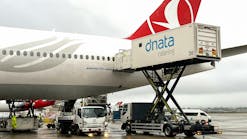How Ground Handlers and Industry Standards Are Developing Together
The IATA Safety Audit for Ground Operations (ISAGO) and the IATA Ground Operations Manual (IGOM) are two of the main industry initiatives that have been implemented internationally to target aircraft ground handling safety. As they become more established, both ISAGO and IGOM are continuing to develop.
“A quick look at the IATA website for both ISAGO and IGOM registry indicates a decent take up. As of March 2019, ISAGO had 410 registrations, 227 providers and 546 airports globally, while IGOM indicated 92 airlines albeit IATA has 250 odd members. The new ISAGO model is delivering a commonly accepted better audit quality but the benefits are not really being seen from a ground handling service provider (GHSP) perspective. One of our larger members saw nearly 900 station audits during 2018. The reduction in audit quantity for GHSPs is simply not materializing. The other initially envisaged benefit of insurance premium reductions for ISAGO registered handlers is also non-existent,” says Jon Conway, director general of the Airport Services Association (ASA).
“To be clear, ASA supports an industry audit standard – ideally against an industry standard ground operations manual (IGOM) – but the vision of ISAGO as a globally adopted and accepted audit standard seems to be some way off. Some of the small/medium size handlers I have spoken to actually appreciate the discipline that ISAGO brings and you will see, especially in some developing markets, good adoption levels by GHSPs. For the ground handling sector, both IGOM and ISAGO are really ‘no brainers’ if widely adopted by our customers. What’s the downside? In my personal view, airlines need to first make the move en mass to IGOM adoption (ideally with zero or minimal variances) – this will naturally help ISAGO become the global audit model.”
“ISAGO is known, but due to changes to the structure and pricing, a lot of GHSPs are hesitating to join before they see where it is going. For Aviator, we have included ISAGO recommendations as a requirement for quality management and document structure. We also use ISAGO checklists for our internal audits. The requirements from ISAGO creates a good, structured basis for us and enables implementations, improvements and other changes to our structure to be controlled and efficient,” says Ola M. Bakk, corporate safety and compliance manager at Aviator.
At Aviator, IGOM is implemented as the company ground operations manual.
“IGOM is a brilliant idea. If there were more widespread use of IGOM, a lot of unnecessary work could be avoided. For GHSPs with several customers, different requirements make a smooth operation somewhat obstructed. As an example, the airlines' difference in placement of chocks and cones are a challenge for GHSPs. At some airports, this could be 30-plus different placements on the same aircraft type. The only thing this does, is creating observations and findings. Not a very good use of resources which could be used for some more proactive activities,” says Bakk. “If more airlines adopted the IGOM standards or accepted that their GHSPs operate according to the basics in IGOM, I am convinced that a higher level of both safety and quality could be reached. We really do not need to add uncertainty and confusion to the ramp environment, or any other part of the handling business for that matter. There would be a lot of benefits to derive from the ISAGO/IGOM structure if only there were some more collaboration from both the airlines and the GHSPs.”
“Swissport is very much supportive of IGOM as an industry standard and we do see similar support from most ground service providers across the world. With Europe – being a market where outsourcing has much progressed over the past – service providers do seek such harmonization of procedures across their customer base. With IGOM standards being promoted via IOSA in the meantime, airline push has been increased. However, allowed variations are – while acknowledged to be needed for special circumstances – still granting a backdoor to maintain procedures substantially different from IGOM,” says Matthias Hüttner, SVP global operation, Swissport International.
The airlines support the ISAGO and the IGOM by incorporating the standards in their internal procedures (the IGOM, the AHM, etc.).
“However, airlines often extend the audit standards by incorporating additional requirements and thus decrease the level of standardization. They do not require their application as a minimum, but questions regarding the ISAGO and the IGOM implementation are always a part of the negotiations,” says Lukas Kral, member of the Czech Airlines Handling Board of Directors.
“To the best of my knowledge, not one airline has ‘required’ ISAGO or IGOM as a minimum tender requirement. London Heathrow is, interestingly, proposing to mandate IGOM as a condition of use for airlines and handlers to operate at LHR. They believe, as does ASA, that reduction in operational complexity via standardized ground handling (ramp specifically) delivers risk reduction and potential safety enhancements,” says Conway.
IGOM procedures are the industry standard and are being developed and enhanced by ground handling experts.
“However, before adjusting or implementing any new or revised standard, Swissport has an expert group consisting of representatives from key markets and geographies review any such. Only with blessing of the experts, eventually including a thorough risk assessment, changes are being implemented. We thus would not consider any specific area more or less work intense, but Swissport pays closest attention whenever changes could affect the safety of our employees and operation,” says Hüttner.
The link between ISAGO and IGOM is very strategic and the interface between the two programs is key.
“Wide adoption of standardized/harmonized operational processes will naturally lead to a standardized/harmonized audit model. We are not there yet. We are involved in the EASA work on Basic Regulation revision (to include ground handling) and they are very keen to see robust industry developed standards to aid the regulatory framework,” says Conway.
“The IGOM enables setting up common procedures both for airlines and the ground handling service providers. The ISAGO and the IGOM programs complement each other. The IGOM is a really helpful document and the first attempt to standardize the ground handling procedures. On the other hand, there is the possibility to set up different procedures for different customers (airlines), which degrades the whole IGOM idea. The ISAGO is the oversight process, but more focused on the satisfaction of the customer airline requirements than the IGOM,” says Kral.
For Aviator, IGOM and ISAGO are two parts of the circle of improvement.
“A full implementation of IGOM, would enhance the capabilities already present in ISAGO. When these are parts of a complete circle/process flow, and the circle/flow is assessed, a constant performance improvement is enabled. For a further interface management/improvement, more GHSPs should be invited into the IATA working groups. The GHSPs are in large extent doing all ground service duties. Airlines seem to be more distant, and don’t have the same view of the present environment on the ground as they used to when providing ground services themselves,” says Bakk.
Looking into the future, as they develop ISAGO and IGOM, there will be a need to cover emerging aircraft ground handling safety issues.
“ISAGO and IGOM should cover all the areas that are a part of the standard ground handling agreement (SGHA), including all the stakeholders involved in the ground handling process,” notes Kral.
“Basically, IGOM and ISAGO are good, but, in particular ISAGO, are very focussed on large airports. As being a GHSP with most of our operations in Scandinavia, the size of operations indicated in ISAGO does only comply with four airports. And that only by a small margin. The scope should take into consideration smaller airports as well. Also, being situated relatively far north, the extreme weather section should be targeted more in detail,” says Bakk.
“IGOM is always developing. It is becoming the ‘minimum standard’ for ground ops but I believe it should become ‘best in class’. Unfortunately, the debate on which is best in class can be extensive. The industry (airlines and handlers) really should develop this idea of best operational process per aircraft type. The recent EASA Ground Operations Conference in Cologne included a real-life example: five aircraft types with a combined 59 chocking and coning requirements. Pity the poor ramp agent? The future ramp will see autonomous vehicle activity increasing, artificial intelligence (AI) applications potentially, robotics … all will need close examination in terms of risk management and standardized ground operations. IGOM and ISAGO groups both meet regularly under IATA auspices to review these and other industry developments,” concludes Conway.





